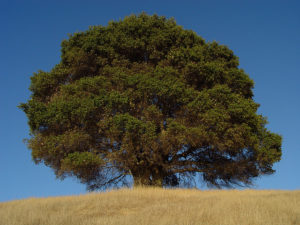Taking Care of Trees During the Drought
 While “Brown is the New Green” becomes our state motto and more people opt to stop watering their lawns, how are we supposed to continue caring for our trees? Lawns are easily replaceable but trees are an important part of our ecosystem providing wildlife habitats, clean air, shade, food for us and for critters, and therefore need to be protected. So how do we do that without breaking the bank and keeping under water restrictions? Patrice Hanlon of the Mercury News has some great tips:
While “Brown is the New Green” becomes our state motto and more people opt to stop watering their lawns, how are we supposed to continue caring for our trees? Lawns are easily replaceable but trees are an important part of our ecosystem providing wildlife habitats, clean air, shade, food for us and for critters, and therefore need to be protected. So how do we do that without breaking the bank and keeping under water restrictions? Patrice Hanlon of the Mercury News has some great tips:
“Watering efficiently could mean changing overhead irrigation to drip, installing a soaker hose that can be circled around the drip line of the tree or manually watering using a hose at a low trickle, allowing the water to percolate into the soil. When watering, think deep and infrequent. If you aren’t sure, get a soil probe and pull out a soil core. If it’s dry and crumbly, then your tree needs water. Our clay soils, which everyone loves to hate, actually are very good at holding water. According to UC Davis’ California Center for Urban Horticulture, trees need to be irrigated to a depth of 3 feet. Go to http://ccuh.ucdavis.edu for additional information about managing landscapes during drought times.
“Healthy roots are the foundation of healthy trees. Look up at the canopy of the tree. That will give you an idea of how far the lateral feeder roots are traveling beyond the trunk. This helps in determining where to water and mulch. Lateral roots extending from the trunk are the most active and essential for bringing water and nutrients to the tree. In addition to feeder roots, a soil fungus called mycorrhiza attaches to the roots and helps to increase nutrient and water absorption.
“Urban and suburban environments cause added stress from soil compaction, root damage from digging or mowing, and nutrient deficiencies. Mulching improves the soil’s retention of water, reduces evaporation from the soil surface, and introduces a cadre of beneficial organisms that improve the overall health of your soil. Add 3 to 4 inches of mulch to the drip line of your tree, but be sure to leave an area about 2 inches from the trunk free of mulch. This will keep the area dry and allow you to notice if there are any problems at the base of the tree.
“Pruning and fertilizing during drought should be limited or eliminated. Do not fertilize your tree if it is already stressed unless you are using organic amendments. High-nitrogen or chemical fertilizers have salts in them that causes the roots to burn if there is not enough moisture in the soil. Pruning can encourage dormant buds to emerge and stimulate new growth. If you need to prune, do it conservatively by only removing what you need to, such as dead, crossing over and competing branches.”
Please also keep in mind that even if you are letting your lawn die, if you have trees nearby they most likely get a lot of their water from the grass. So pay attention to the soil near the tree to know when it’s thirsty!
Here is a link to the original article: http://www.mercurynews.com/home-garden/ci_27999236/care-trees-during-drought
